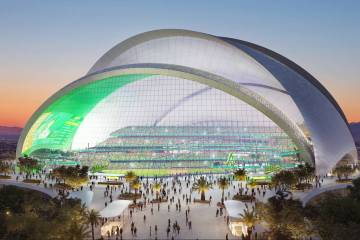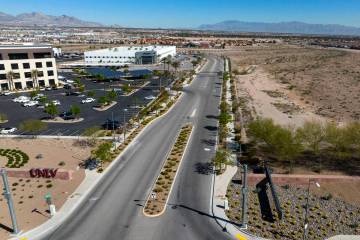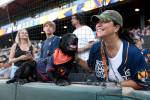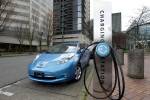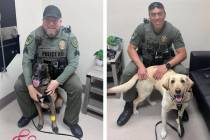UNLV showcases humanoid robot on global stage
UNLV engineering student Truc Tran stood next to a robot Monday just before turning on its power.
After flipping a switch, the 26-year-old waited for a few minutes for charging at the university’s Drones and Autonomous Systems Lab.
After a green light came on, the robot was ready.
“Now, the motor and every device is turned on,” Tran said.
Tran, who’s working toward a master’s degree, and 28-year-old Baekseok Kim, a doctoral degree student in mechanical engineering, demonstrated how the team’s avatar system — dubbed Avatar-Hubo — moves its arms and legs.
After four years of work, UNLV students recently showed off their robot on a global stage.
A university team was among 17 groups that participated in an ANA Avatar XPRIZE finals testing event Nov. 4-5 in Long Beach, California. It ranked 11th overall.
Participating teams included universities and companies hailing from 10 countries. They were vying for millions of dollars in prize money.
UNLV’s nine-member team began working on the project after the competition was announced in 2018. Its avatar system is essentially an extension of the person who’s operating it.
The humanoid robot can be controlled by an operator who’s using wearable technology. The operator can even feel and see what the robot does.
The project incorporates artificial intelligence, virtual reality and haptics, or touch-related technology.
The end goal is telepresence — feeling and being somewhere else “without physically being in that location,” said team member Nicolas Kosanovic, 22, who’s finishing his bachelor’s degree in mechanical engineering.
UNLV’s team was among more than 100 from across the world that applied for the XPRIZE competition.
The team competed in the semifinals in September 2021 in Miami and qualified for the finals, receiving about $133,000 in funding to continue working on its project.
The competition gave students the opportunity to see what others in the field are doing, UNLV mechanical engineering professor Paul Oh said.
“It’s something they can proudly look back on,” he said.
Oh said he wanted students “to be in the same room as the world’s best.” Unlike some places such as California or Boston, there’s not much in Las Vegas to benchmark against, he said.
Work already happening at UNLV
XPRIZE was pitching the idea of telepresence, and that seemed to resonate with work already happening in UNLV’s lab, Oh said.
The lab’s focus for years has been on disaster response. A system that allows for transporting a doctor or firefighter’s expertise, for example, “using a robot as your agent is very intriguing,” he said.
That could mean having a robot physically on-site, while it’s being controlled remotely from a safe location.
In 2015, a UNLV team placed eighth in an international robotics competition — the Defense Advanced Research Projects Agency robotics challenge — that was focused on disaster response.
With humanoids and avatars, “I think we just touched the surface,” Oh said, noting that the technology is important and will be part of everyone’s daily lives. And due to the COVID-19 pandemic, telepresence has become more important, he added.
In the future, one application could be using avatar systems to deliver health care in Nevada, especially in rural and remote areas, Oh said.
And for resorts and the entertainment industry, it’s a question of how augmented reality could be used, and Las Vegas has the opportunity to be at the forefront, he said.
Competing at the finals
The exact format of the XPRIZE finals testing event this month was kept secret, Oh said, noting that teams are often designing “in the dark.”
A lot of UNLV’s infrastructure and the robot itself were repurposed following the 2015 challenge. But there were other items such as virtual reality equipment and haptic sensors the team purchased.
At the finals testing event, the team’s robot was controlled by a judge who had received about 40 minutes of training on how to use UNLV’s system.
The team tried to perform its best and navigate some of the curveballs thrown its way at the competition, said team captain Jean Chagas Vaz, a research scientist with UNLV’s Drones and Autonomous Systems Lab.
What he learned: “You have to make a robot that can win versus doing your best to repurpose a robot.”
The team, Vaz said, tried to build a mobile base for the robot but ran out of time and funding.
“Aside from that, we had all of the components to perform all of the tasks,” he said.
The task course “created a bit of a challenge for our robot,” Tran said.
Tasks included picking up canisters, identifying which one was heavy and manipulating an electrical switch.
Tran said the team didn’t receive the prize it wanted but learned a lot.
“It was very fun for me because a lot of people don’t have the chance to compete in a very big competition like this,” he said.
Tran got involved with the project in June by creating the robot’s hand using a 3D printer at home, and modifying it for the tasks the robot needed to complete. It took Tran about two months to create the first prototype.
He earned his bachelor’s degree in mechanical engineering at UNLV, and after spending 2½ years working in the industry, he returned to pursue a master’s degree.
Moving forward, Tran is undecided on whether he wants to pursue a doctoral degree or venture into the world of entrepreneurship — potentially launching a startup company making prosthetic hands for humans.
And for UNLV’s lab, the competition may be over, but the work continues.
The competition pushes labs to innovate, Vaz said. “The technology is far from being complete.”
Contact Julie Wootton-Greener at jgreener@reviewjournal.com or 702-387-2921. Follow @julieswootton on Twitter.




